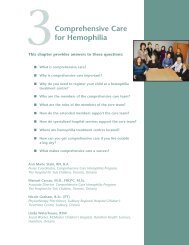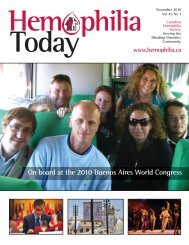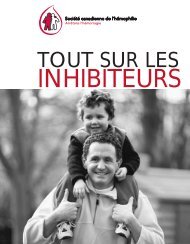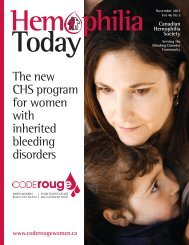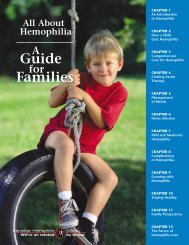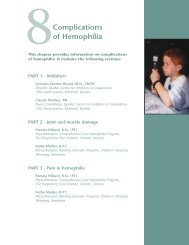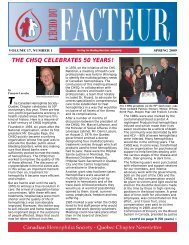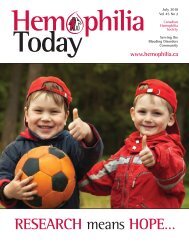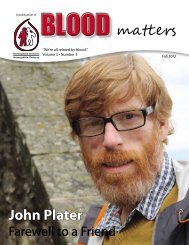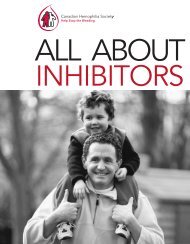Canadian Hemophilia Society
Canadian Hemophilia Society
Canadian Hemophilia Society
Create successful ePaper yourself
Turn your PDF publications into a flip-book with our unique Google optimized e-Paper software.
Medical news<br />
The Nurses’ Station<br />
<strong>Hemophilia</strong> nurse coordinators are learning “MI”<br />
Dorine Belliveau, RN, nurse coordinator, <strong>Hemophilia</strong> Clinic, Horizon Health Network, Moncton, New Brunswick<br />
You may have heard the words “motivational interviewing” in<br />
recent months. This new concept is being introduced to nurses<br />
and other comprehensive care team members in <strong>Canadian</strong><br />
hemophilia treatment centres, but has been used with success for<br />
about a decade in other chronic health conditions such as diabetes<br />
and cystic fibrosis.<br />
Motivational interviewing (MI) used in the health care setting is a<br />
person-centred way of interviewing patients with the goal being to<br />
help them make individual changes towards improved health<br />
outcomes. In the “spirit” of MI, the nurse coordinator invites the patient<br />
to decide how the interview will flow, gently reflects on the positive<br />
words spoken by the patient, and shows a genuine interest and curiosity<br />
toward the patient’s feelings and attitudes about change. Sometimes<br />
the nurse coordinator will ask the patient about the “upsides” and<br />
“downsides” of change. At the same time, the nurse and the patient<br />
may examine the positive and negative aspects of continuing the same<br />
behaviour. The patient can then decide how confident he/she is about<br />
being able to change and maintain the new behaviour.<br />
As a nurse coordinator in a hemophilia treatment centre with<br />
many years of experience, I sometimes find myself in situations<br />
where I feel that a patient I am caring for does not have optimal<br />
health because of the way he/she manages his/her bleeding<br />
disorder. I have found myself in the “expert trap” referred to in<br />
motivational interviewing literature, wherein I would try to<br />
convince patients that a change in behaviour would be in their best<br />
interests. I would give long explanations, show pictures, and hand<br />
out printed materials, never asking them if they were interested in<br />
what I was offering. I was the expert and it was my job to give them<br />
all the information that I felt they needed.<br />
Motivational learning has helped me come to learn that it is not<br />
all about me – it is all about the patient! And this is changing my<br />
way of interacting with patients in clinic.<br />
Should Ice be part of RICE?<br />
David Page, CHS national executive director<br />
No, not according to a review just published in Haemophilia<br />
by a team of researchers, including Nichan Zourikian and<br />
Dr. Georges-Étienne Rivard, respectively physiotherapist and<br />
clinic director at the CHU Sainte-Justine in Montreal.<br />
RICE (rest, ice, compression and elevation) have long been<br />
recommended, along with factor replacement therapy, to treat joint<br />
and muscle bleeding in people with hemophilia. The theory was that<br />
ice would cause blood vessels to constrict, thereby slowing bleeding.<br />
This new peer-reviewed paper, however, raises questions about the<br />
efficacy of ice in slowing or stopping bleeding. Indeed, it suggests<br />
that the application of ice could impair the coagulation process and<br />
make bleeding worse.<br />
The researchers state: “There is lack of evidence within the general<br />
literature indicating a beneficial effect of ice on clinical outcome<br />
after acute soft-tissue injury.” They go on to write: “The use of ice<br />
may pose a risk in a person with hemophilia (PWH) due to its effects<br />
on the coagulation system and platelet functions, thereby impairing<br />
hemostasis. While this effect might be less relevant in the general<br />
population in whom the hemostatic mechanism is intact, it may be<br />
very important when treating PWH.”<br />
18 | <strong>Hemophilia</strong> Today November 2012<br />
The researchers cited studies showing that the temperature inside<br />
the knee joint is reduced, depending on the duration and technique<br />
of ice application, from the normal 37ºC to anywhere from 20 to<br />
30ºC. Other studies in people without hemophilia (and a very small<br />
study in people with hemophilia) as well as animals have shown<br />
longer bleeding times when the skin surrounding the hemorrhage<br />
was exposed to cold. In other words, hemostasis takes place best<br />
at body temperature. Application of ice can be tempting, the<br />
researchers note, as cooling of the joint can temporarily reduce pain.<br />
They conclude: “In PWH, with hemarthrosis, the use of ice appears<br />
to have a greater risk than benefit. Therefore, ice application in the<br />
treatment of acute hemarthrosis should be questioned. Additional<br />
studies are needed, specifically in the field of bleeding disorders to<br />
provide high-quality evidence surrounding the potential risks<br />
associated with ice in PWH with hemarthrosis, whether there exists<br />
any net, beneficial effect of ice, and to better define the role of ice<br />
in clinical outcomes for this population.”<br />
A. L. FORSYTH, N. ZOURIKIAN, L. A. VALENTINO and G. E. RIVARD. Haemophilia (2012),<br />
1–8 | The effect of cooling on coagulation and haemostasis: Should “Ice” be part<br />
of treatment of acute haemarthrosis in haemophilia?



